Morphological and Anatomical Characterization of Stems in Lilium Taxa
Abstract
1. Introduction
2. Materials and Methods
2.1. Plant Materials
2.2. Phenotyping
2.3. Comparative Cultivation
2.4. Transverse Section Preparation
2.5. Descriptive and Quantitative Anatomy of Stems
2.6. Statistical Analysis
3. Results
3.1. Morphological Characterization of Lily Stems
3.2. Growth Posture Analysis
3.3. Stem Cross-Section Morphology
3.4. Cuticle Characteristics
3.5. Epidermal Cells Morphology
3.6. Trichomes, Papillae and Stoma
3.7. Cortex and Sclerenchymatous Ring
3.8. Vascular Cylinder
3.9. Correlation Analysis
3.10. Genetic Relationship Based on 23 Morphological and Anatomical Indices
4. Discussion
4.1. Vascular Bundle Influence Lilium Stem Bending
4.2. Comparison of Stem Anatomical Characteristics Between Lilium and Other Monocots
4.3. Concluding Remarks: Taxonomic Significance of Anatomical Characteristic in Lilium
Supplementary Materials
Author Contributions
Funding
Data Availability Statement
Conflicts of Interest
Abbreviations
References
- Du, Y.; He, H.; Wang, Z.; Wei, C.; Li, S.; Jia, G. Investigation and Evaluation of the Genus Lilium Resources Native to China. Genet. Resour. Crop Evol. 2014, 61, 395–412. [Google Scholar] [CrossRef]
- Du, Y.; Wei, C.; Wang, Z.; Li, S.; He, H.; Jia, G. Lilium Spp. Pollen in China (Liliaceae): Taxonomic and Phylogenetic Implications and Pollen Evolution Related to Environmental Conditions. PLoS ONE 2014, 9, e87841. [Google Scholar] [CrossRef]
- Li, J.; Chen, J.; Zhang, Q.; Yu, P.; Zhou, Y.; Jia, G. The Composition of Anthocyanins and Carotenoids Influenced the Flower Color Heredity in Asiatic Hybrid Lilies. Horticulturae 2022, 8, 1206. [Google Scholar] [CrossRef]
- Du, F.; Jiang, J.; Jia, H.; Zhao, X.; Wang, W.; Gao, Q.; Mao, W.; Wu, Y.; Zhang, L.; Grierson, D.; et al. Selection of Generally Applicable SSR Markers for Evaluation of Genetic Diversity and Identity in Lilium. Biochem. Syst. Ecol. 2015, 61, 278–285. [Google Scholar] [CrossRef]
- Duan, Q.; Liu, F.; Gui, D.; Fan, W.; Cui, G.; Jia, W.; Zhu, A.; Wang, J. Phylogenetic Analysis of Wild Species and the Maternal Origin of Cultivars in the Genus Lilium Using 114 Plastid Genomes. Front. Plant Sci. 2022, 13, 865606. [Google Scholar] [CrossRef]
- Bányai, Á.; Horváth, G. Biomechanics of Plant Stems with Square and Circular Cross-Sections: What Is the Advantage of Quadratic Stems over Cylindrical Ones? Proc. R. Soc. Math. Phys. Eng. Sci. 2025, 481, 20240445. [Google Scholar] [CrossRef]
- Heredia, A.; Benítez, J.J.; González Moreno, A.; Domínguez, E. Revisiting Plant Cuticle Biophysics. New Phytol. 2024, 244, 65–73. [Google Scholar] [CrossRef]
- Zhang, H.; Liu, P.; Wang, B.; Yuan, F. The Roles of Trichome Development Genes in Stress Resistance. Plant Growth Regul. 2021, 95, 137–148. [Google Scholar] [CrossRef]
- Kanofre, E.B.S.; Monteiro, M.M. Anatomy of the Scape in Hypolytreae species (Mapanioideae, Cyperaceae): Comparative Analysis and Phylogenetic Implications. Braz. J. Bot. 2025, 48, 2–9. [Google Scholar] [CrossRef]
- Yembaturova, E.Y.; Korchagina, A.V. Stem and Leaf Anatomy of Highly Ornamental Representatives of the Genus Lilium. Acta Hortic. 2011, 900, 43–51. [Google Scholar] [CrossRef]
- Torres-Pio, K.; De La Cruz-Guzmán, G.H.; Arévalo-Galarza, M.D.L.; Aguilar-Rodríguez, S.; Grego-Valencia, D.; Arriaga-Frías, A.; Mandujano-Piña, M. Morphological and Anatomical Changes in Lilium Cv. Arcachon in Response to Plant Growth Regulators. Hortic. Environ. Biotechnol. 2021, 62, 325–335. [Google Scholar] [CrossRef]
- Liu, Z.; Li, J.; Gao, C.; Miao, Y.; Cui, K. The Cellulose–Lignin Balance Mediated by Auxin Signal Transduction Affects the Twisted Growth of Yunnan Pine Trunk. Sci. Hortic. 2023, 317, 112085. [Google Scholar] [CrossRef]
- Ge, Y.; Lai, Q.; Luo, P.; Liu, X.; Chen, W. Transcriptome Profiling of Gerbera Hybrida Reveals That Stem Bending Is Caused by Water Stress and Regulation of Abscisic Acid. BMC Genom. 2019, 20, 600. [Google Scholar] [CrossRef]
- Perik, R.R.J.; Razé, D.; Harkema, H.; Zhong, Y.; van Doorn, W.G. Bending in Cut Gerbera Jamesonii Flowers Relates to Adverse Water Relations and Lack of Stem Sclerenchyma Development, Not to Expansion of the Stem Central Cavity or Stem Elongation. Postharvest Biol. Technol. 2012, 74, 11–18. [Google Scholar] [CrossRef]
- Zhao, D.; Shi, W.; Xia, X.; Tang, Y.; Tao, J. Microstructural and Lignin Characteristics in Herbaceous Peony Cultivars with Different Stem Strengths. Postharvest Biol. Technol. 2020, 159, 111043. [Google Scholar] [CrossRef]
- Li, X.R. Cloning and Expression Analysis of the Genes Related to Lignin Synthesis from Lilium Oriental Hybrids; Nanjing Forestry University: Nanjing, China, 2009. [Google Scholar]
- Yan, G.X.; Zhang, M.X.; Zhang, Z.M. Effects of the Simulated Wave on the Bio-mechanical Characteristics of Two Typical Coastal Wetland Plants. Acta Ecol. Sin. 2021, 41, 3784–3793. [Google Scholar]
- Chebli, Y.; Bidhendi, A.J.; Kapoor, K.; Geitmann, A. Cytoskeletal Regulation of Primary Plant Cell Wall Assembly. Curr. Biol. 2021, 31, R681–R695. [Google Scholar] [CrossRef]
- Zemunik, G.; Turner, B.; Lambers, H.; Laliberté, E. Diversity of Plant Nutrient-Acquisition Strategies Increases during Long-Term Ecosystem Development. Nature 2015, 1, 15050. [Google Scholar] [CrossRef]
- Guimarães, A.R. Stem and Leaf Morphoanatomy of Two Atlantic Forest Species of Smilax Linnaeus. Rev. Biol. Neotropical 2011, 8, 1–14. [Google Scholar] [CrossRef]
- Bidhendi, A.J.; Lampron, O.; Gosselin, F.P.; Geitmann, A. Cell Geometry Regulates Tissue Fracture. Nat. Commun. 2023, 14, 8275. [Google Scholar] [CrossRef]
- Kandmir, N.; Celik, A.; Ermis, A. Comparative Leaf and Scape Anatomy of Some Scilla taxa in Turkey. Int. J. Agric. Biol. 2016, 18, 957–964. [Google Scholar] [CrossRef]
- Martins, A.R.; Bombo, A.B.; Soares, A.N.; Appezzato-da-Glória, B. Aerial Stem and Leaf Morphoanatomy of Some Species of Smilax. Rev. Bras. Farmacogn. 2013, 23, 576–584. [Google Scholar] [CrossRef]
- Khorasani, M.; Mehrvarz, S.S.; Zarre, S. Scape Anatomy and Its Systematic Importance in the Allium Stipitatum Species Complex (Amaryllidaceae). Nord. J. Bot. 2018, 36, e02008. [Google Scholar] [CrossRef]
- Aybeke, M. Comparative Anatomy of Selected Rhizomatous and Tuberous Taxa of Subfamilies Orchidoideae and Epidendroideae (Orchidaceae) as an Aid to Identification. Plant Syst. Evol. 2012, 298, 1643–1658. [Google Scholar] [CrossRef]
- Subha, T.; Gnanamani, A.; Mandal, A. Pharamcognostic Evaluation of Acorus Calamus L. Pharmacogn. J. 2011, 3, 24–27. [Google Scholar] [CrossRef]
- Alemán-Sancheschúlz, G.; Solano, E.; Terrazas, T.; López-Portillo, J. Functional Anatomy and Xylem Cavitation Resistance of Three Species of Monocotyledons Grown on Flooded Substrates. Physiol. Plant. 2020, 169, 571–585. [Google Scholar] [CrossRef]
- Ronse De Craene, L. Understanding the Role of Floral Development in the Evolution of Angiosperm Flowers: Clarifications from a Historical and Physico-Dynamic Perspective. J. Plant Res. 2018, 131, 367–393. [Google Scholar] [CrossRef]
- Stojanović, J. Comparative Morpho- Anatomical Analysis of Gagea Pratensis (Pers.) Dumort. (Liliaceae) from Serbia and Montenegro. Biol. Nyssana 2019, 10, 125–133. [Google Scholar]
- Bhanot, V.; Fadanavis, S.V.; Panwar, J. Revisiting the Architecture, Biosynthesis and Functional Aspects of the Plant Cuticle: There Is More Scope. Environ. Exp. Bot. 2021, 183, 104364. [Google Scholar] [CrossRef]
- Du, F.; Li, X.T.; Xu, X.J.; Yuan, Y.; Chang, L.; Zhang, X.Y. Study on the Genetic Diversity and Classification Analysis of Lilium Cultivars. J. Shanxi Agric. Univ. (Nat. Sci. Ed.) 2018, 38, 16–22. [Google Scholar]
- Soykan, A.; Meriç, Ç. Morphological and Anatomical Studies of Tulip Orphanidea (Liliaceae). Phytol. Balc. 2012, 18, 43–48. [Google Scholar]
- Watts, S.; Kariyat, R. Morphological Characterization of Trichomes Shows Enormous Variation in Shape, Density and Dimensions across the Leaves of 14 Solanum Species. AoB Plants 2021, 13, plab071. [Google Scholar] [CrossRef]
- Akyol, Y.; Kocabas, O.; Yet, K.; Bozdag, B.; Ozdem, C. Morphological and Anatomical Investigations of Some Gagea Salisb. Species (Liliaceae) in Turkey. J. Biol. Res. Dev. 2015, 5, 1–10. [Google Scholar]
- Kandemir, N.; Çelik, A.; Shah, S.N.; Albasher, G.; Iqbal, M. Taxonomic Relevance of Stem and Leaf Anatomy in 10 Endemic Fritillaria Species from the Mediterranean Region. Flora 2024, 310, 152444. [Google Scholar] [CrossRef]
- Hückelhoven, R. The Effective Papilla Hypothesis. New Phytol. 2014, 204, 438–440. [Google Scholar] [CrossRef]
- Jupa, R.; Plichta, R.; Paschova, Z.; Nadezhdina, N.; Gebauer, R. Mechanisms Underlying the Long-Term Survival of the Monocot Dracaena marginata Under Drought Conditions. Tree Physiol. 2017, 37, 1182–1197. [Google Scholar] [CrossRef] [PubMed]
- Claßen-Bockhoff, R.; Franke, D.; Krähmer, H. Early Ontogeny Defines the Diversification of Primary Vascular Bundle Systems in Angiosperms. Bot. J. Linn. Soc. 2021, 195, 281–307. [Google Scholar] [CrossRef]
- Akinbade, Y.; Nettleship, I.; Papadopoulos, C.; Harries, K.A. Modelling Full-Culm Bamboo as a Naturally Varying Functionally Graded Material. Wood Sci. Technol. 2021, 55, 155–179. [Google Scholar] [CrossRef]
- Namazi, F.; Sharifi-Tehrani, M.; Shabani, L. Anatomical study on Fritillaria species in Iran. Bangladesh J. Bot. 2017, 46, 93–101. [Google Scholar]
- Yeşil Cantürk, Y.; Özhatay, F. Scape, Rhizome and Root Anatomy of Polygonatum Species from Turkey. Eur. J. Biol. 2021, 80, 164–172. [Google Scholar] [CrossRef]
- Fu, X.P.; Zhou, Y.Q.; Liu, J.Y.; Yang, J.W.; Zhang, W.W. Epipremnum aureum for observing the primary structure of stem of monocotyledonous plants. J. Sci. Teach. Coll. Univ. 2023, 2, 102–105. [Google Scholar]
- Tenorio, V.; Couto, R.S.; De Albuquerque, E.S.B.; Medeiros, A.M.L.; De Oliveira Ferreira, R.; Braga, J.M.A.; Vieira, R.C. Stem Anatomy of Neotropical Dioscorea L. (Dioscoreaceae) and Its Importance to the Systematics of the Genus. Plant Syst. Evol. 2017, 303, 775–786. [Google Scholar] [CrossRef]
- Dhyani, A.; Bahuguna, Y.M.; Semwal, D.P.; Nautiyal, B.P.; Nautiyal, M.C. Anatomical Features of Lilium Polyphyllum D. Don Ex Royle (Liliaceae). J. Am. Sci. 2009, 5, 85–90. [Google Scholar]
- Behzad, K.; Dehkaei, M.; Darabi, A.H.; Rafizadeh, A.; Rahmati, B. The Anatomical Properties of Endemic Lilium Ledebourii (Baker) Bioss. (Liliaceae) Species. Int. J. Bot. 2008, 4, 62–66. [Google Scholar]
- Lundgren, M.R.; Osborne, C.P.; Christin, P.-A. Deconstructing Kranz Anatomy to Understand C4 Evolution. J. Exp. Bot. 2014, 65, 3357–3369. [Google Scholar] [CrossRef]
- Rakhimova, N.K.; Duschanova, G.M.; Abdullaeva, A.T.; Temirov, E.E. Anatomical Structure of Aboveground and Underground Organs of the Rare Endemic Species Iris (Juno) magnifica vved., Growing under Natural Conditions of the Zeravshan Ridge, Samarkand Mountains. Am. J. Plant Sci. 2020, 11, 1453–1466. [Google Scholar] [CrossRef]
- Perrier, L.; Rouan, L.; Jaffuel, S.; Clément-Vidal, A.; Roques, S.; Soutiras, A.; Baptiste, C.; Bastianelli, D.; Fabre, D.; Dubois, C.; et al. Plasticity of Sorghum Stem Biomass Accumulation in Response to Water Deficit: A Multiscale Analysis from Internode Tissue to Plant Level. Front. Plant Sci. 2017, 8, 1516. [Google Scholar] [CrossRef]
- Huang, C.; Chen, Q.; Xu, G.; Xu, D.; Tian, J.; Tian, F. Identification and Fine Mapping of Quantitative Trait Loci for the Number of Vascular Bundle in Maize Stem. J. Integr. Plant Biol. 2016, 58, 81–90. [Google Scholar] [CrossRef] [PubMed]
- Niu, Y.N.; Chen, T.X.; Zhao, C.C.; Guo, C.; Zhou, M.X. Identification of QTL for Stem Traits in Wheat (Triticum aestivum L.). Frotiers Plant Sci. 2022, 13, 962253. [Google Scholar] [CrossRef]
- Wu, L.; Zhang, W.; Ding, Y.; Zhang, J.; Cambula, E.D.; Weng, F.; Liu, Z.; Ding, C.; Tang, S.; Chen, L.; et al. Shading Contributes to the Reduction of Stem Mechanical Strength by Decreasing Cell Wall Synthesis in Japonica Rice (Oryza Sativa L.). Front. Plant Sci. 2017, 8, 881. [Google Scholar] [CrossRef]
- Qin, D.D.; Liu, R.; Xu, F. Characterization of a Barley (Hordeum vulgare L.) Mutant with Multiple Stem Nodes and Spikes and Dwarf (msnsd) and Fine-mapping of Its Causal Gene. Front Plant Sci. 2023, 14, 1189743. [Google Scholar] [CrossRef] [PubMed]
- Mulyaningsih, T.; Karnika, D.A.; Muspiah, A. Comparison of stem anatomy of Bambusa vulgaris Schrad and Schizostachyum brachycladum (Kurz) Kurz (Poaceae) in Lombok. Adances Bamboo Sci. 2022, 1, 100010. [Google Scholar] [CrossRef]
- Mousa, M.O.; Abood, N.M.; Shahatha, S.S.; Alawadi, H.F.N. Anatomical Study of the Stems of Some Wild Species of Poaceae Family in the Western Desert. IOP Conf. Ser. Earth Environ. Sci. 2021, 735, 012051. [Google Scholar] [CrossRef]
- Fooladi, M.; Moogouei, R.; Jozi, S.A.; Golbabaei, F.; Tajadod, G. Phytoremediation of BTEX from indoor air by Hyrcanian plants. Environ. Health Eng. Manag. J. 2019, 6, 233–240. [Google Scholar] [CrossRef]
- Liang, D.; Zhang, M.; Liu, X.; Li, H.; Jia, Z.; Wang, D.; Peng, T.; Hao, M.; Liu, D.; Jiang, B.; et al. Development and Identification of Four New Synthetic Hexaploid Wheat Lines with Solid Stems. Sci. Rep. 2022, 12, 4898. [Google Scholar] [CrossRef]
- Marcondes, J.P.B.D.A.C.; Trevisan, R.; Moço, M.C.D.C.; Bona, C. Diversity and Evolution of Stem Structure in Eleocharis (Cyperaceae). Rodriguésia 2021, 72, e01012020. [Google Scholar] [CrossRef]
- Güven, S.; Okur, S.; Demırel, M.S.; Coskuncelebi, K.; Makbul, S.; Beyazoğlu, O. Pollen Morphology and Anatomical Features of Lilium (Liliaceae) Taxa from Turkey. Biologia 2014, 69, 1122–1133. [Google Scholar] [CrossRef][Green Version]
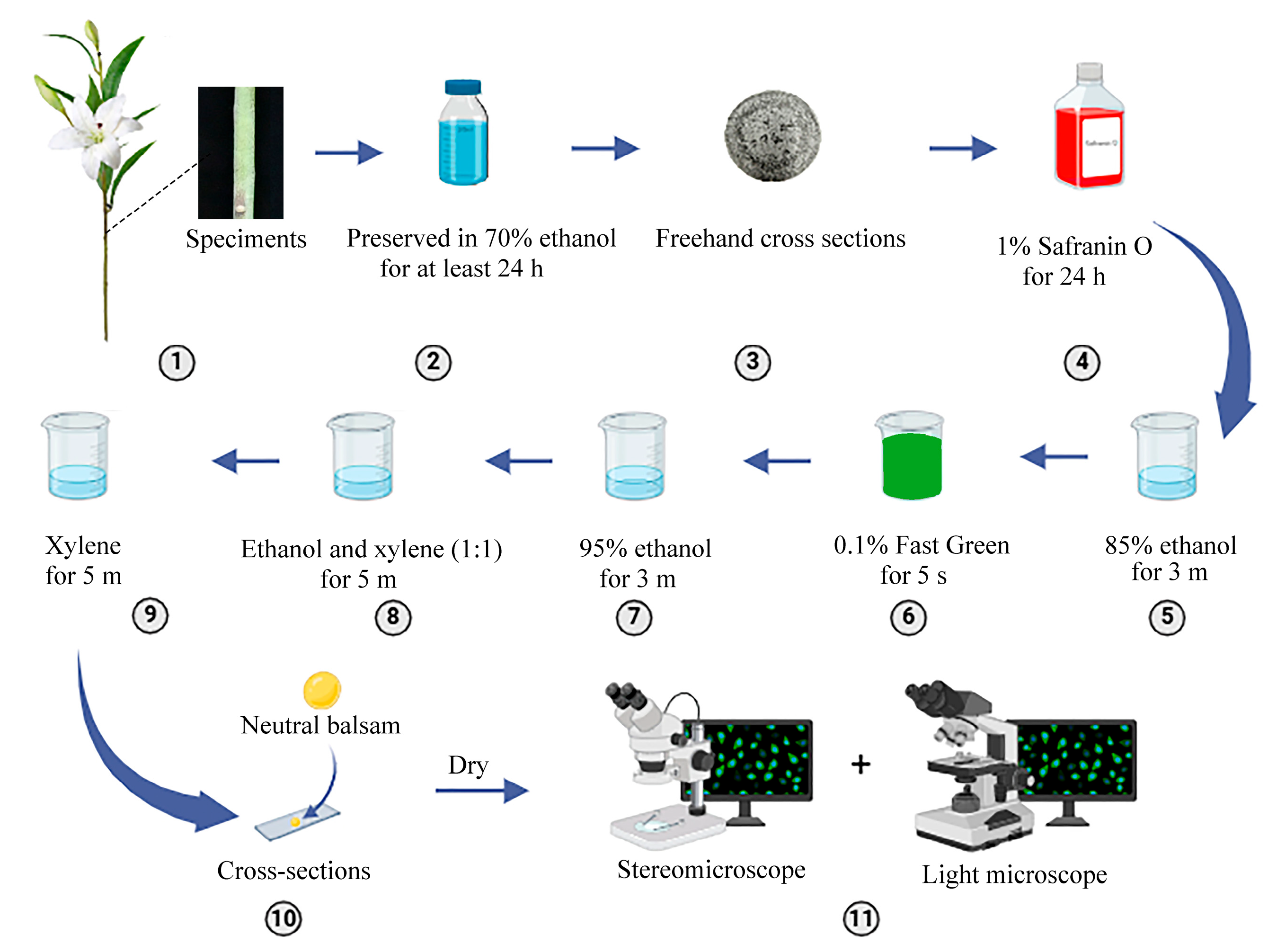
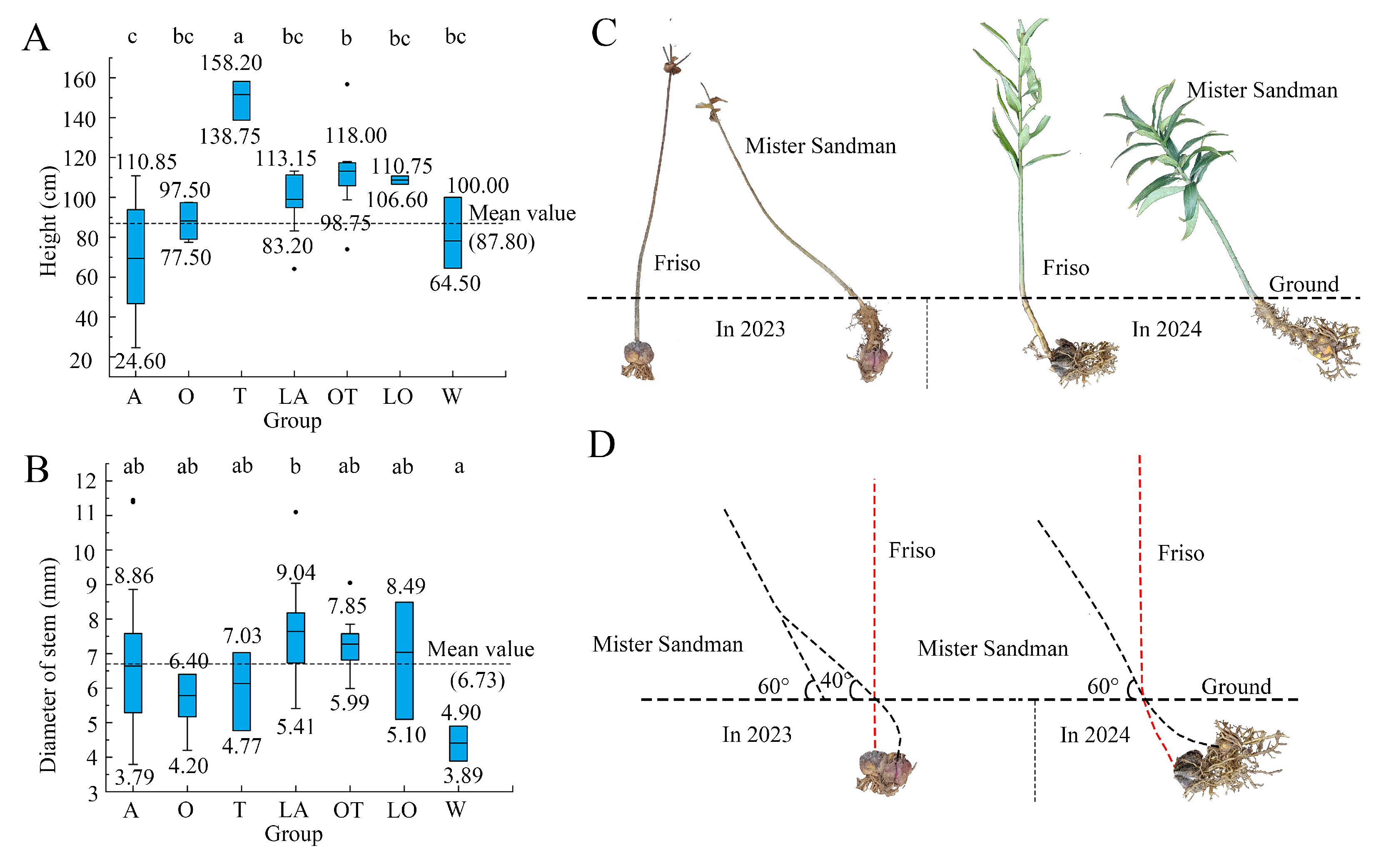



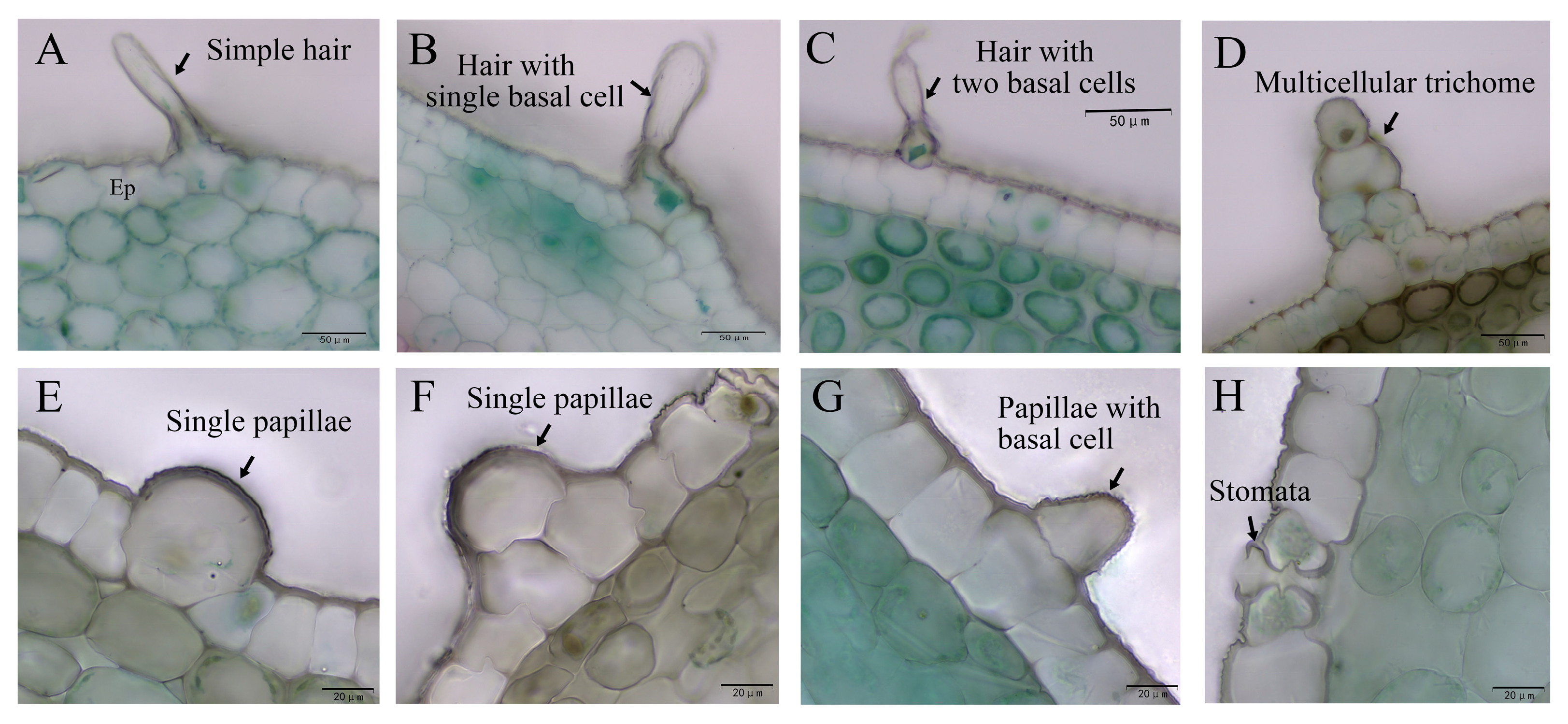



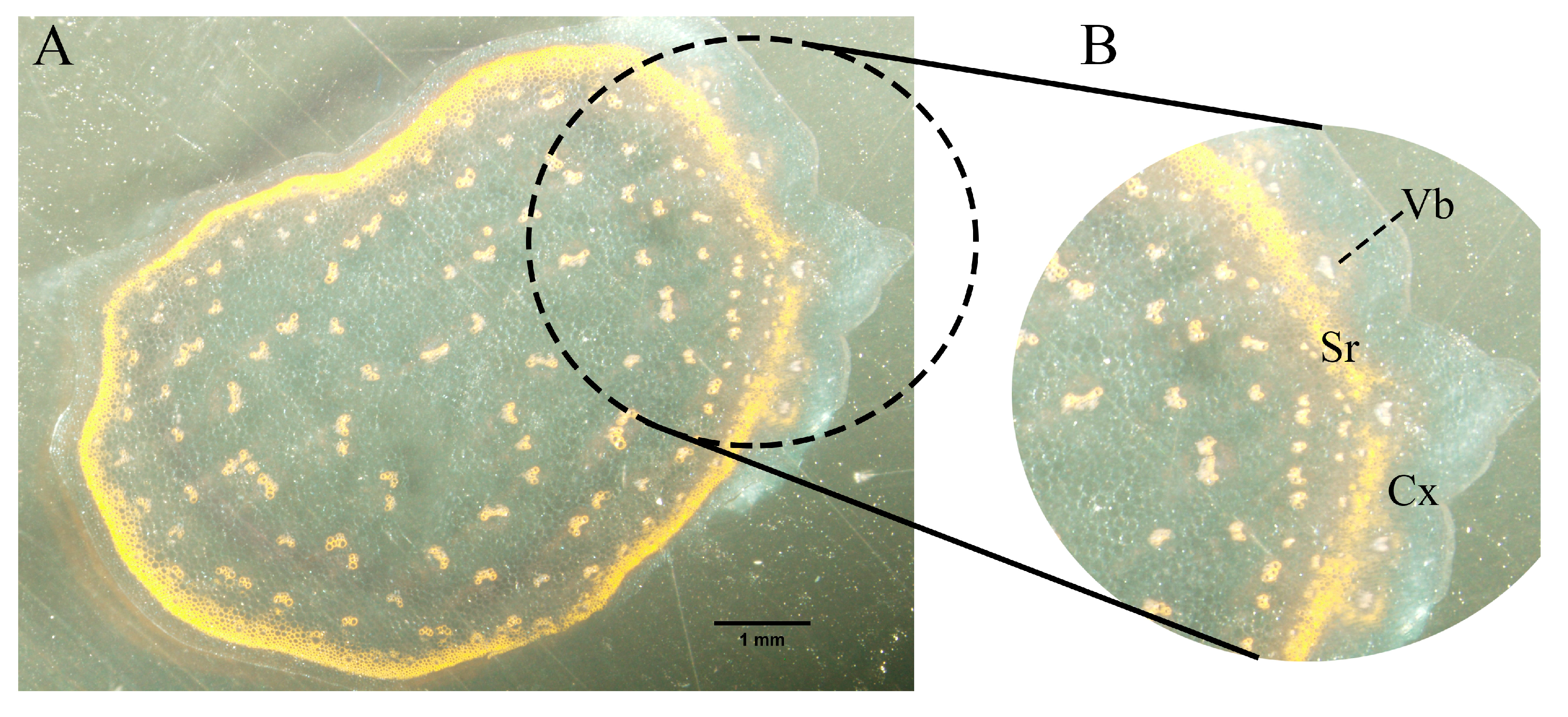
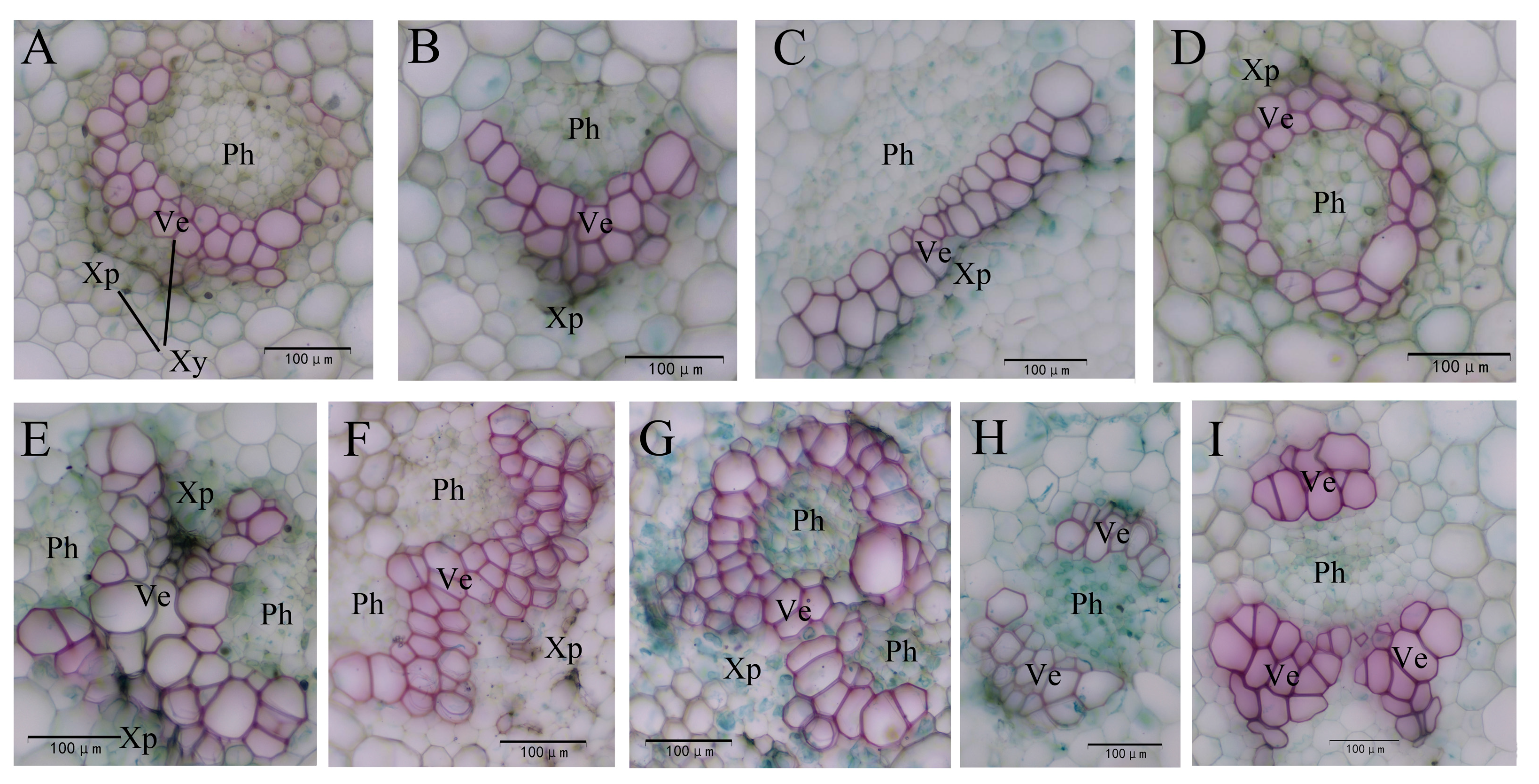
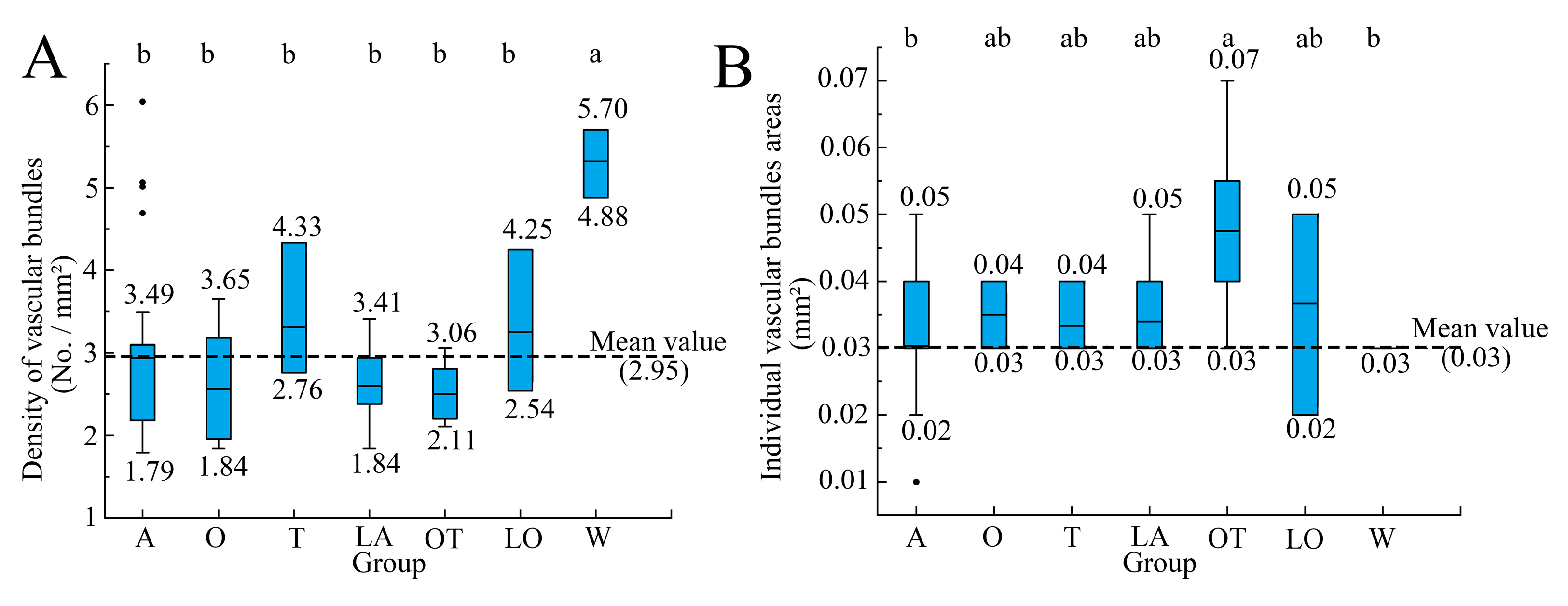

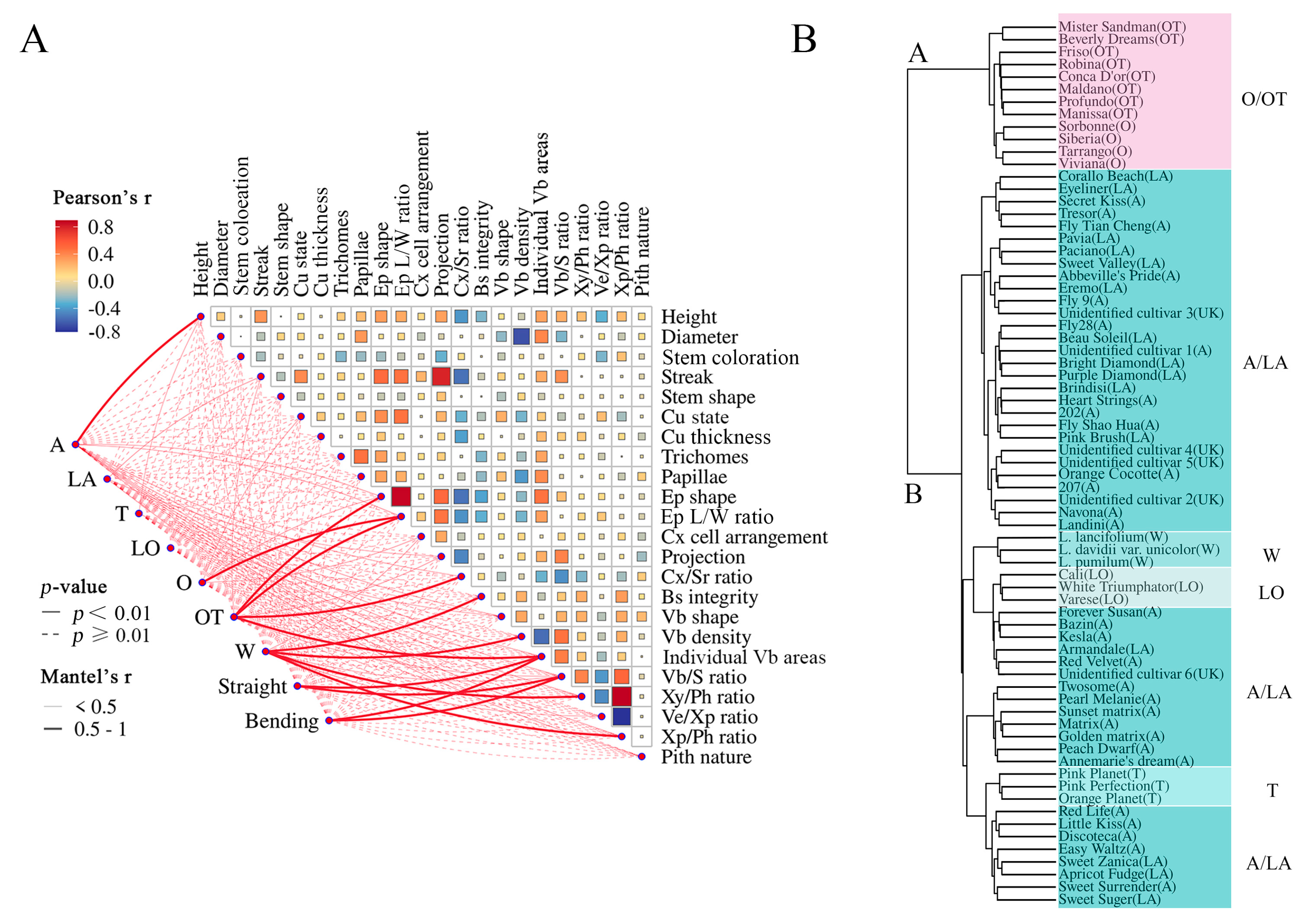
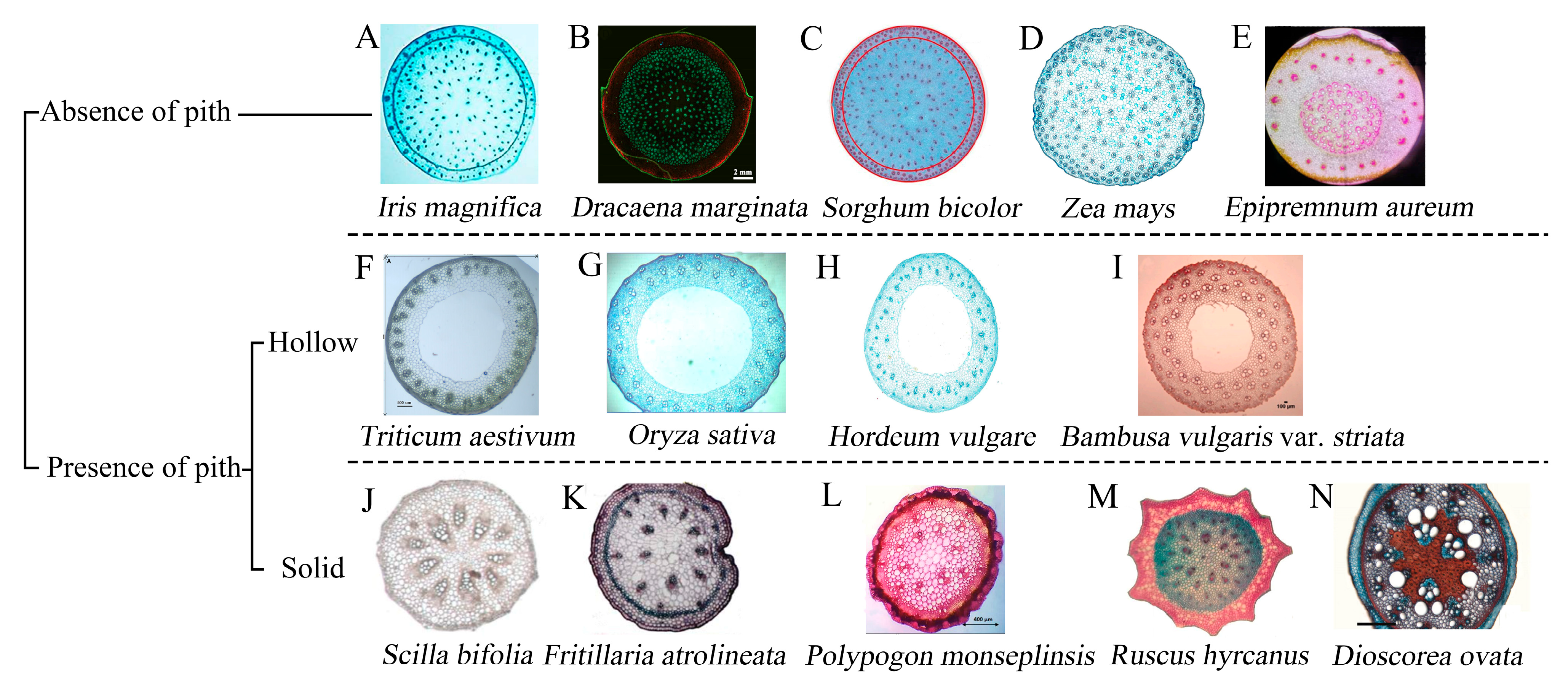
| No. | Group | Name | No. | Group | Name | No. | Group | Name |
|---|---|---|---|---|---|---|---|---|
| 1 | A | Easy Waltz a | 25 | A | Kesla b | 49 | LA | Eyeliner b |
| 2 | A | Little Kiss a | 26 | A | Fly 28 b | 50 | LA | Sweet Sugar a |
| 3 | A | Peach Dwarf a | 27 | A | Fly 9 b | 51 | LA | Bright Diamond a |
| 4 | A | Abbeville’s Pride a | 28 | A | 207 b | 52 | LA | Purple Diamond a |
| 5 | A | Twosome a | 29 | A | 202 b | 53 | OT | Maldano b |
| 6 | A | Forever Susan a | 30 | A | Unidentified cultivar 1 b | 54 | OT | Profundo b |
| 7 | A | Red Life a | 31 | O | Sorbonne a | 55 | OT | Conca D’or b |
| 8 | A | Annemarie’s Dream a | 32 | O | Siberia a | 56 | OT | Friso a |
| 9 | A | Matrix a | 33 | O | Tarrango b | 57 | OT | Mister Sandman a |
| 10 | A | Sunset Matrix a | 34 | O | Viviana b | 58 | OT | Manissa a |
| 11 | A | Golden Matrix a | 35 | T | Pink Perfection a | 59 | OT | Robina a |
| 12 | A | Pearl Melanie a | 36 | T | Orange Planet a | 60 | OT | Beverly Dreams a |
| 13 | A | Navona a | 37 | T | Pink Planet a | 61 | LO | Cali b |
| 14 | A | Landini a | 38 | LA | Pavia a | 62 | LO | White Triumph b |
| 15 | A | Discoteca a | 39 | LA | Pink Brush b | 63 | LO | Varese b |
| 16 | A | Sweet Surrender b | 40 | LA | Eremo b | 64 | W | L. lancifoliuma |
| 17 | A | Secret Kiss b | 41 | LA | Armandale b | 65 | W | L. davidii var. unicolor a |
| 18 | A | Red Velvet b | 42 | LA | Beau Soleil b | 66 | W | L. pumiluma |
| 19 | A | Orange Cocotte b | 43 | LA | Paciano b | 67 | UK | Unidentified cultivar 2 b |
| 20 | A | Heart Strings b | 44 | LA | Sweet Zanica b | 68 | UK | Unidentified cultivar 3 b |
| 21 | A | Tresor b | 45 | LA | Brindisi b | 69 | UK | Unidentified cultivar 4 b |
| 22 | A | Fly Tian Cheng b | 46 | LA | Apricot Fudge b | 70 | UK | Unidentified cultivar 5 b |
| 23 | A | Fly Shao Hua b | 47 | LA | Corallo Beach b | 71 | UK | Unidentified cultivar 6 b |
| 24 | A | Bazin b | 48 | LA | Sweet Valley b |
Disclaimer/Publisher’s Note: The statements, opinions and data contained in all publications are solely those of the individual author(s) and contributor(s) and not of MDPI and/or the editor(s). MDPI and/or the editor(s) disclaim responsibility for any injury to people or property resulting from any ideas, methods, instructions or products referred to in the content. |
© 2025 by the authors. Licensee MDPI, Basel, Switzerland. This article is an open access article distributed under the terms and conditions of the Creative Commons Attribution (CC BY) license (https://creativecommons.org/licenses/by/4.0/).
Share and Cite
Zhou, P.; Liao, K.; Feng, X.; Liang, R.; Teng, N.; Du, F. Morphological and Anatomical Characterization of Stems in Lilium Taxa. Horticulturae 2025, 11, 546. https://doi.org/10.3390/horticulturae11050546
Zhou P, Liao K, Feng X, Liang R, Teng N, Du F. Morphological and Anatomical Characterization of Stems in Lilium Taxa. Horticulturae. 2025; 11(5):546. https://doi.org/10.3390/horticulturae11050546
Chicago/Turabian StyleZhou, Peng, Kuangkuang Liao, Xiunian Feng, Rui Liang, Nianjun Teng, and Fang Du. 2025. "Morphological and Anatomical Characterization of Stems in Lilium Taxa" Horticulturae 11, no. 5: 546. https://doi.org/10.3390/horticulturae11050546
APA StyleZhou, P., Liao, K., Feng, X., Liang, R., Teng, N., & Du, F. (2025). Morphological and Anatomical Characterization of Stems in Lilium Taxa. Horticulturae, 11(5), 546. https://doi.org/10.3390/horticulturae11050546






